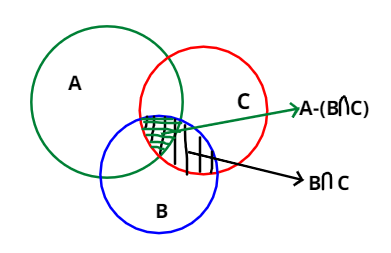
If \[{\text{A}} = \{ 10,15,20,25,30,35,40,45,50\} \],
\[{\text{B}} = \{ 1,5,10,15,20,30\} \] and
\[{\text{C}} = \{ 7,8,15,20,35,45,48\} ,\] find \[{\text{A}} - ({\text{B}} \cap {\text{C}})\].
Answer
560.4k+ views
Hint:- Draw Venn’ diagram. First find \[{\text{B}} \cap {\text{C}}\].

As, we are given with three sets and that were,
\[ \Rightarrow {\text{A}} = \{ 10,15,20,25,30,35,40,45,50\} ,\]
\[ \Rightarrow {\text{B}} = \{ 1,5,10,15,20,30\} \] and
\[ \Rightarrow {\text{C}} = \{ 7,8,15,20,35,45,48\} \]
And asked to find \[{\text{A}} - ({\text{B}} \cap {\text{C}})\].
And as we know that in set theory \[ \cap \] depicts intersection.
\[ \Rightarrow \]An intersection of two sets gives us the common elements of both sets.
So, \[{\text{B}} \cap {\text{C}}\] will give us common elements of sets B and C
\[ \Rightarrow \]So, \[{\text{(B}} \cap {\text{C) }} = {\text{ }}\{ 1,5,10,15,20,30\} \cap \{ 7,8,15,20,35,45,48\} = \{ 15,20\} \]
As we know that if X and Y are some sets then,
\[ \Rightarrow \]X-Y will give us a set having all elements of X excluding elements of Y.
So, \[{\text{A}} - ({\text{B}} \cap {\text{C}})\] will give us those elements of set A which are not in set \[{\text{(B}} \cap {\text{C)}}\]
\[ \Rightarrow \]\[{\text{A}} - ({\text{B}} \cap {\text{C}}) = \{ 10,15,20,25,30,35,40,45,50\} - \{ 15,20\} \]
\[ \Rightarrow \]Hence, \[{\text{A}} - ({\text{B}} \cap {\text{C}}) = \{ 10,25,30,35,40,45,50\} \]
Note:- Whenever we come up with this type of problem then first, we have to Draw Venn’s diagram because this will give proper clarity for the problem. Then remember that for any set X and Y, X-Y will give us a set having all elements of
X excluding elements of Y.

As, we are given with three sets and that were,
\[ \Rightarrow {\text{A}} = \{ 10,15,20,25,30,35,40,45,50\} ,\]
\[ \Rightarrow {\text{B}} = \{ 1,5,10,15,20,30\} \] and
\[ \Rightarrow {\text{C}} = \{ 7,8,15,20,35,45,48\} \]
And asked to find \[{\text{A}} - ({\text{B}} \cap {\text{C}})\].
And as we know that in set theory \[ \cap \] depicts intersection.
\[ \Rightarrow \]An intersection of two sets gives us the common elements of both sets.
So, \[{\text{B}} \cap {\text{C}}\] will give us common elements of sets B and C
\[ \Rightarrow \]So, \[{\text{(B}} \cap {\text{C) }} = {\text{ }}\{ 1,5,10,15,20,30\} \cap \{ 7,8,15,20,35,45,48\} = \{ 15,20\} \]
As we know that if X and Y are some sets then,
\[ \Rightarrow \]X-Y will give us a set having all elements of X excluding elements of Y.
So, \[{\text{A}} - ({\text{B}} \cap {\text{C}})\] will give us those elements of set A which are not in set \[{\text{(B}} \cap {\text{C)}}\]
\[ \Rightarrow \]\[{\text{A}} - ({\text{B}} \cap {\text{C}}) = \{ 10,15,20,25,30,35,40,45,50\} - \{ 15,20\} \]
\[ \Rightarrow \]Hence, \[{\text{A}} - ({\text{B}} \cap {\text{C}}) = \{ 10,25,30,35,40,45,50\} \]
Note:- Whenever we come up with this type of problem then first, we have to Draw Venn’s diagram because this will give proper clarity for the problem. Then remember that for any set X and Y, X-Y will give us a set having all elements of
X excluding elements of Y.
Recently Updated Pages
Master Class 11 Economics: Engaging Questions & Answers for Success

Master Class 11 Accountancy: Engaging Questions & Answers for Success

Master Class 11 English: Engaging Questions & Answers for Success

Master Class 11 Social Science: Engaging Questions & Answers for Success

Master Class 11 Biology: Engaging Questions & Answers for Success

Master Class 11 Physics: Engaging Questions & Answers for Success

Trending doubts
1 ton equals to A 100 kg B 1000 kg C 10 kg D 10000 class 11 physics CBSE

Difference Between Prokaryotic Cells and Eukaryotic Cells

One Metric ton is equal to kg A 10000 B 1000 C 100 class 11 physics CBSE

1 Quintal is equal to a 110 kg b 10 kg c 100kg d 1000 class 11 physics CBSE

Draw a diagram of nephron and explain its structur class 11 biology CBSE

Explain zero factorial class 11 maths CBSE




